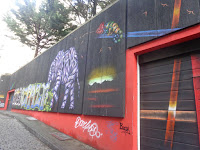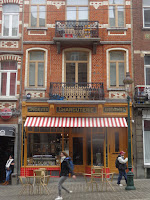If you take the train from the Brussels airport to central station, the minute you exit, you see an outlet of the Scottish brewery Brewdog. It's not exactly the Belgian brown cafe you are hoping for, but after a day of traveling, it's a welcome sight, especially when one of the guest taps is local De Ranke Brewery's Noir de Dottignies strong dark ale (top left). It's enough to fortify you for the walk to your room at B&B Les Clarisses (top right), which is right up the street from Winehouse Osteria and directly across from some pretty spectacular murals (bottom left). Inside, it's equally artistic, with a narrow little staircase that matches the narrow little alley it sits on (bottom right).
In a city full of artistic masterpieces, including Rene Magritte's Son of Man, it's really surreal that every tourist wants to see the Manneken Pis, a tiny statue that often is adorned in costumes like a porch-step goose (top left). It's perhaps even more absurd that right across the street, a larger replica appears to be taking a leak on a collection of Belgian waffles (top right). But then, a few blocks away, no one stops to admire the shop of a true artist, making musical masterpieces (bottom).But for us beer trappers, we were on the hunt for a different kind of craftsperson. In our attempt to find En Stoemelings, which brews everything by hand, we stumbled upon two drinking institutions. At Les Marseillais, its many patrons had clearly mastered the art of day drinking. At La Broncante, there were fewer patrons (left), but one of them was literally creating art at a sunlit table. I watched the man's skill with colored pencils as I sipped Brasserie de la Senne's Brusseleir dark ale (right).
We never did find the actual brewery, but we sampled some En Stoemelings at dinner at Nuetnigenough. The restaurant has an extensive bottle list and includes beer in almost all of its offerings, including our terrine appetizer (top). With our mains, we tried Belgium's two top potato specialties: frites with TJ's pork cheeks and stoemp with my blood sausages (bottom left). We were happy we arrived early, so we could easily snag a no-reservations table amid the small eatery's framed and bottled art (bottom right).
After dinner, we strolled through the rain-soaked streets and lamp-lit facades of the old city, including the appropriately named Grand-Place (top left). We took a shortcut through the Galeries Royales Saint-Hubert (top right) to reach A La Mort Subite (bottom left), a 1920s institution whose name means "At the Sudden Death" (fun fact: I am pretty sure this bar was used as a set in The Danish Girl, filling in as Paris during that time period). We finished the night at a much more modern drinking establishment, Moeder Lambic, conveniently located about a block from our B&B (bottom right).
The highlight of our 24-hour whirlwind tour was a visit to the Brussels Museum of the Gueuze, which is really just the Cantillon Brewery, a family business that has been open since 1900 (top left). We took a self-guided tour of the operation, which utilizes mostly original 19th-century equipment, including the mash tun (top right). The brewery's pride and joy is a copper cooling tun, which is where the magic wild fermentation happens (bottom left). The brewery is so dedicated to consistency that it replaced its aging roof over a decade in an attempt maintain the strains of yeast found in the rafters. At the end of tour in the tasting room (bottom right), we drank lambic straight from the barrel, then compared it to gueuze, a blend of lambics with secondary bottle fermentation, and framboise, a lambic infused with raspberries that is blended with young lambic for secondary fermentation.
We could've lingered all day at the brewery, but before we boarded our train to Luxembourg, we opted for one more Belgian meal. On the way, we passed Porte de Hal, a gate of the medieval city that has been turned into -- what else -- an art museum (top left). We ate across from the Town Hall of Saint-Gilles, a neighborhood known for its art nouveau architecture (top right). We wanted to try a culinary mainstay at Brasserie de la Renaissance (bottom left). We remembered that a recommended dish started with a "C" in French, and unfortunately, our waitress was one of the few who didn't speak English. So we pressed our luck and ordered two "C" dishes from the specials board. TJ was the lucky winner of the carbonnade, like boeuf Bourguignon but with beer instead of wine (bottom right). Fortunately, my cod with chorizo was equally delicious.




















































